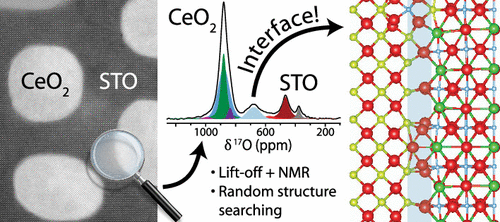当前位置:
X-MOL 学术
›
Chem. Mater.
›
论文详情
Our official English website, www.x-mol.net, welcomes your
feedback! (Note: you will need to create a separate account there.)
Revealing the Structure and Oxygen Transport at Interfaces in Complex Oxide Heterostructures via 17O NMR Spectroscopy
Chemistry of Materials ( IF 7.2 ) Pub Date : 2020-08-19 , DOI: 10.1021/acs.chemmater.0c02698 Michael A. Hope 1 , Bowen Zhang 2 , Bonan Zhu 2 , David M. Halat 1 , Judith L. MacManus-Driscoll 2 , Clare P. Grey 1
Chemistry of Materials ( IF 7.2 ) Pub Date : 2020-08-19 , DOI: 10.1021/acs.chemmater.0c02698 Michael A. Hope 1 , Bowen Zhang 2 , Bonan Zhu 2 , David M. Halat 1 , Judith L. MacManus-Driscoll 2 , Clare P. Grey 1
Affiliation

|
Vertically aligned nanocomposite (VAN) films, comprising nanopillars of one phase embedded in a matrix of another, have shown great promise for a range of applications due to their high interfacial areas oriented perpendicular to the substrate. In particular, oxide VANs show enhanced oxide-ion conductivity in directions that are orthogonal to those found in more conventional thin-film heterostructures; however, the structure of the interfaces and its influence on conductivity remain unclear. In this work, 17O NMR spectroscopy is used to study CeO2–SrTiO3 VAN thin films: selective isotopic enrichment is combined with a lift-off technique to remove the substrate, facilitating detection of the 17O NMR signal from single atomic layer interfaces. By performing the isotopic enrichment at variable temperatures, the superior oxide-ion conductivity of the VAN films compared to the bulk materials is shown to arise from enhanced oxygen mobility at this interface; oxygen motion at the interface is further identified from 17O relaxometry experiments. The structure of this interface is solved by calculating the NMR parameters using density functional theory combined with random structure searching, allowing the chemistry underpinning the enhanced oxide-ion transport to be proposed. Finally, a comparison is made with 1% Gd-doped CeO2–SrTiO3 VAN films, for which greater NMR signal can be obtained due to paramagnetic relaxation enhancement, while the relative oxide-ion conductivities of the phases remain similar. These results highlight the information that can be obtained on interfacial structure and dynamics with solid-state NMR spectroscopy, in this and other nanostructured systems, our methodology being generally applicable to overcome sensitivity limitations in thin-film studies.
中文翻译:

通过17 O NMR光谱揭示复杂氧化物异质结构界面的结构和氧传输
垂直排列的纳米复合材料(VAN)膜包含嵌入在另一相的基体中的一个相的纳米柱,由于其垂直于基材取向的高界面区域,已显示出了广泛的应用前景。特别地,氧化物VANs在与更常规的薄膜异质结构中发现的方向正交的方向上显示出增强的氧化物离子电导率。然而,界面的结构及其对导电性的影响仍不清楚。在这项工作中,使用17 O NMR光谱研究CeO 2 -SrTiO 3 VAN薄膜:选择性同位素富集与剥离技术相结合,去除了底物,便于检测17来自单原子层界面的O NMR信号。通过在可变温度下进行同位素富集,与大块材料相比,VAN薄膜具有更高的氧化物电导率,这是由于该界面处的氧迁移率提高所致。根据17 O弛豫法实验进一步确定了界面处的氧运动。通过使用密度泛函理论与随机结构搜索相结合的NMR参数计算来解决此界面的结构,从而可以提出化学基础,以增强氧化物离子的转运。最后,进行了1%Gd掺杂的CeO 2 -SrTiO 3的比较。VAN薄膜,由于顺磁性弛豫增强,可以获得更大的NMR信号,而相的相对氧化物离子电导率保持相似。这些结果突显了在此纳米结构系统和其他纳米结构系统中,使用固态NMR光谱学可获得的界面结构和动力学信息,我们的方法通常可用于克服薄膜研究中的灵敏度限制。
更新日期:2020-09-22
中文翻译:

通过17 O NMR光谱揭示复杂氧化物异质结构界面的结构和氧传输
垂直排列的纳米复合材料(VAN)膜包含嵌入在另一相的基体中的一个相的纳米柱,由于其垂直于基材取向的高界面区域,已显示出了广泛的应用前景。特别地,氧化物VANs在与更常规的薄膜异质结构中发现的方向正交的方向上显示出增强的氧化物离子电导率。然而,界面的结构及其对导电性的影响仍不清楚。在这项工作中,使用17 O NMR光谱研究CeO 2 -SrTiO 3 VAN薄膜:选择性同位素富集与剥离技术相结合,去除了底物,便于检测17来自单原子层界面的O NMR信号。通过在可变温度下进行同位素富集,与大块材料相比,VAN薄膜具有更高的氧化物电导率,这是由于该界面处的氧迁移率提高所致。根据17 O弛豫法实验进一步确定了界面处的氧运动。通过使用密度泛函理论与随机结构搜索相结合的NMR参数计算来解决此界面的结构,从而可以提出化学基础,以增强氧化物离子的转运。最后,进行了1%Gd掺杂的CeO 2 -SrTiO 3的比较。VAN薄膜,由于顺磁性弛豫增强,可以获得更大的NMR信号,而相的相对氧化物离子电导率保持相似。这些结果突显了在此纳米结构系统和其他纳米结构系统中,使用固态NMR光谱学可获得的界面结构和动力学信息,我们的方法通常可用于克服薄膜研究中的灵敏度限制。









































 京公网安备 11010802027423号
京公网安备 11010802027423号